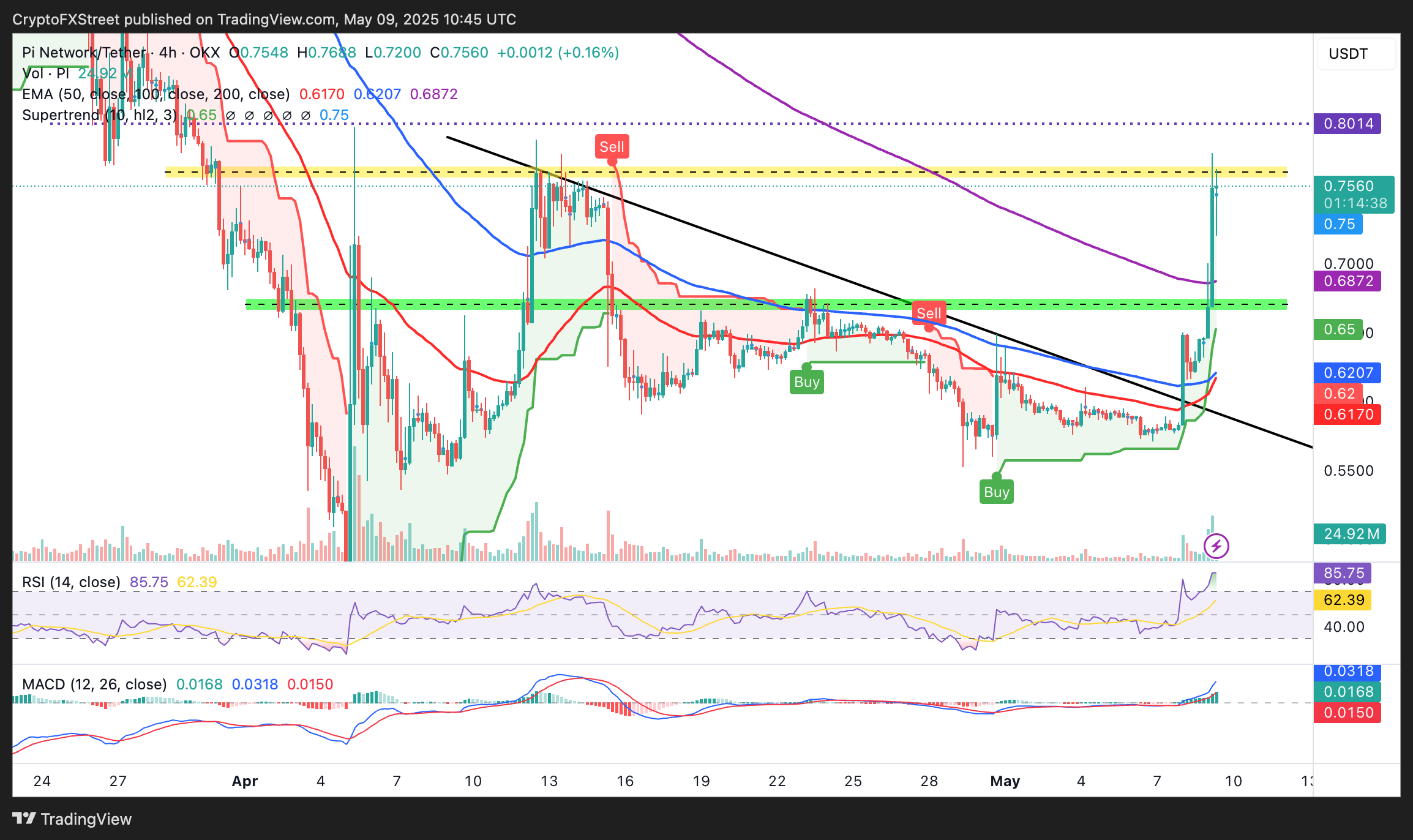Pi Network rally halts under $0.80 as traders speculate about upcoming ecosystem announcement
- Pi Network’s recent price action sends multiple buy signals, but resistance under $0.80 appears to be capping the uptrend.
- The Pi Network team teases a major announcement on May 14, fueling speculation and trader interest on the coin.
- Overbought conditions alongside resistance below $0.80 signal a potential trend correction ahead of the weekend.
Pi Network (PI) price extends gains while trading at $0.75 at the time of writing on Friday posting a second consecutive day of double-digit increases. The tailwind on PI can be attributed to a broad-based bullish momentum as risk-on sentiment surged following a limited bilateral trade agreement between the United States (US) and the United Kingdom. Still, apart from the broader positive market mood, the Pi team hinted at a big announcement on May 14, stirring up excitement and speculation among users.
Pi Network uptrend takes a breather
The Pi Network Core team teased a major ecosystem announcement on Thursday, sparking speculation of, among other things, a listing on Binance, the largest exchange by trading volume.
The announcement comes after the platform carried a major update to make the mainnet ecosystem more accessible to users while maintaining strict security standards. According to a blog post published on May 2, verified pioneers, including those with full or tentative know your customer (KYC) approval, can activate Mainnet wallets via the Pi Wallet app before the migration completes.
The new features allow non-users to join the ecosystem by directly creating Mainnet wallets using third-party services after passing set KYC requirements. Pi Network aims to boost inclusivity with this update while accelerating global adoption before the full Open Network launch.
Pi Network uptrend set to continue
Pi Network’s rally has taken a temporary breather after encountering selling pressure at $0.77, while moving to close the gap at $0.80. The token currently hovers at $0.75 at the time of writing, up more than 16% on the day.
Since April 30, its uptrend has been supported by a buy signal from the SuperTrend indicator. Such a signal is confirmed when the trend-following indicator slides below the price, changing its colour to green from red.
This encouraged traders to position themselves ahead of a potential breakout, which gained momentum after price broke above the descending trendline resistance, as shown on the 4-hour chart below.
Pi Network’s uptrend progressed above the 50-, 100-, and 200-period Exponential Moving Averages (EMAs), signaling robust bullish momentum. However, extremely overbought conditions revealed by the Relative Strength Index (RSI) indicator at 85.78 challenge the uptrend, hinting at increasing chances of profit-taking.
A reversal of the RSI indicator into the neutral region below 70 would provide a clear sell signal amid declining trader interest and confidence. Should a decline occurr key support levels likely to absorb the selling pressure include the 200 EMA at $0.68 and the confluence area at $0.62, which aligns with the 50 EMA and the 100 EMA.

PI/USDT 4-hour chart
For now, the Moving Average Convergence Divergence (MACD) indicator is above the center line, signaling strong bullish momentum. Additionally, the green histograms are growing, bolstering the short-term bullish outlook.
Therefore, dismissing a bigger-than-expected rally past $0.80 might be premature in the coming days, especially with the Pi Core team hinting at a major ecosystem announcement for May 14.
Cryptocurrency prices FAQs
Token launches influence demand and adoption among market participants. Listings on crypto exchanges deepen the liquidity for an asset and add new participants to an asset’s network. This is typically bullish for a digital asset.
A hack is an event in which an attacker captures a large volume of the asset from a DeFi bridge or hot wallet of an exchange or any other crypto platform via exploits, bugs or other methods. The exploiter then transfers these tokens out of the exchange platforms to ultimately sell or swap the assets for other cryptocurrencies or stablecoins. Such events often involve an en masse panic triggering a sell-off in the affected assets.
Macroeconomic events like the US Federal Reserve’s decision on interest rates influence crypto assets mainly through the direct impact they have on the US Dollar. An increase in interest rate typically negatively influences Bitcoin and altcoin prices, and vice versa. If the US Dollar index declines, risk assets and associated leverage for trading gets cheaper, in turn driving crypto prices higher.
Halvings are typically considered bullish events as they slash the block reward in half for miners, constricting the supply of the asset. At consistent demand if the supply reduces, the asset’s price climbs.



